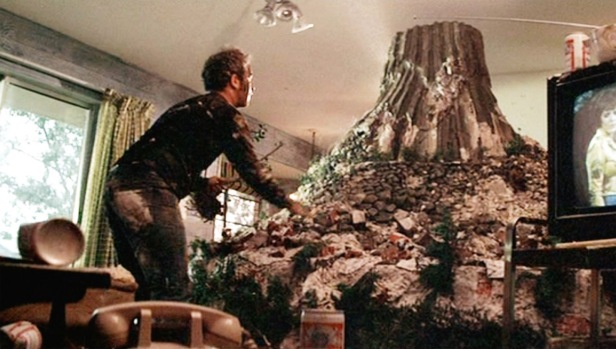Director: Steven Spielberg
Writer: Steven Spielberg
Cast: Richard Dreyfuss, François Truffaut, Teri Garr, Melinda Dillon
“da da da, daa daaaaaaaaa”
Steven Spielberg’s Close Encounters of the Third Kind was re-released for one night only, just last night, to celebrate its 40th anniversary. Despite it being a modern, polished 4K rendering of the movie, we went to see it with all the wide-eyed wonder of someone sitting in the audience in 1977. Audiences then were still stunned from seeing Star Wars and were quickly prepared to be dazed by another sci-fi epic that same year.
This cut of Close Encounters is Spielberg’s definitive cut, with the Mongolia sequence, and a few extra edits added along the way. This version does not, however, include the divisive scene in which Richard Dreyfuss sees th inside of the mothership, a scene which Spielberg never wanted in the film, as he wanted to leave that part open to the audience’s imagination.

Spielberg started making Close Encounters straight after finishing Jaws, a movie credited for starting off the age of the modern summer blockbuster, so the studios were ready to throw money at any project he brought them. It was Columbia who accepted the project, and although they were ready to support Spielberg all the way, Close Encounters was a movie that would either make or break the studio, Columbia being at risk of bankruptcy. Another unprecedented problem was the title of the movie: “Close Encounters of the Third Kind”? What does that even mean? “well,” said Spielberg, “that’s when you meet ’em!”
Spielberg decided early on that this was not a science fiction movie, but more of a “science speculation” film, set against the backdrop of everyday American life and infused with the political drama that came with the aftermath of Watergate. The magic of Close Encounters is entirely down to this “Speculation” and Spielberg’s belief that what he was showing us could do, or might have already happened. He was a self-professed UFO enthusiast who believed in life on other worlds, and he let this kooky optimism fill this movie. However, he side-stepped the usual conspiracy theories and tin-foil hat ideas, and made a movie full of childhood wonder, which drives the story and comes across in the performances of Dreyfuss, Truffaut and Dillon.
Spielberg has said that a major theme for Close Encounters, and indeed many of his later movies, is that of a child opening a door and seeing the light, just like little Barry does in this movie. In Close Encounters, Spielberg opens the door for us, and invites us to share in his child-like naive wonder. The innocent optimism of Close Encounters is something which is so lacking in many movies now, that watching this in the cinema today feels like a massive breath of fresh air.

The ambition of Close Encounters was as awe-inspiring as the aliens’ light show. This is where the special effects deserve a mention. Utilising state of the art technology, and innovative new ideas, Spielberg made some of the brightest, most spectacular scenes that big screen had ever seen (he got the original idea for the bright, fleeting lights by watching the runway at LAX at night). He has said that, since Jaws, nothing has been as hard to film as his first blockbuster, but the last 25 minutes of Close Encounters was the hardest thing he has ever had to edit together.
Inspired by an Indian oil refinery turned on its head, combined with the lights of the San Fernando Valley, the alien mothership was the crowning glory of this film. Spielberg’s original idea was of something much darker and foreboding, but when Ralph McQuarrie (concept artist for George Lucas on Star Wars) drew up an idea, Spielberg took it and ran with it. The end result differs little from McQuarrie’s drawing, showing the true power that a vision or an idea can have on the final product.

The influence that Close Encounters has had on all subsequent sci-fi films is undeniable. It’s clear that the swirling movement of the clouds above Wyoming’s Devil’s Tower, inspired the emergence of the alien space ships from the clouds in Independence Day. The home invasion scene, where Barry gets abducted, is riffed on in the ending of Shyamalan’s Signs. Most recently, however, we have Denis Villeneuve’s Arrival. Like Close Encounters, Arrival focuses on the actual first contact, and the huge hurdle that would undoubtably face us in real life: communicating with E.T. They both face this problem with scientifically grounded methods, using mathematics and symbols (and in the case of Close Encounters, music) to communicate, rather than guns, tanks and nukes to obliterate. This movie lies in the domain of intelligent, thoughtful (dare I say realistic?) sci-fi films, rather than your typical alien invasion fare.
Finally, we come to the music. John Williams came straight from Star Wars to score Close Encounters, and you can hear tones of his earlier magical score here and there throughout this film. Spielberg was concerned that Williams would not have enough leftover after Star Wars to give to this project, but his fears were definitely unfounded. Williams comes to Close Encounters with one of his most memorable soundtracks, and some of the most famous five notes in movie history. The leitmotif permeates the music here and there, hinting at a bigger score to come until the blinding and triumphantly operatic finale, where the theme comes into its own. Da da da, daa daaaaaaa!

